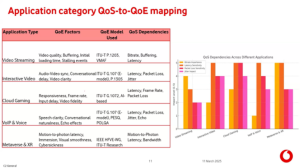 Bridging the gap between QoE and QoS can ensure better service quality for applications such as video streaming, gaming, and real time communications. But when trialing a new technology, Vodafone’s Mayur Channegowda explained, lab and field trials don’t tell the whole story. It is difficult to gauge if the user will actually receive better QoE. It’s important that we can understand how infrastructure performance translates to QoE.
Bridging the gap between QoE and QoS can ensure better service quality for applications such as video streaming, gaming, and real time communications. But when trialing a new technology, Vodafone’s Mayur Channegowda explained, lab and field trials don’t tell the whole story. It is difficult to gauge if the user will actually receive better QoE. It’s important that we can understand how infrastructure performance translates to QoE.
QoE requirements that guide network engineering can enhance user experience, optimize network design, help focus network investments, and improve resource allocation efficiency.
Mayur discussed the Telecom Infra Project (TIP) MRN QoE Engineering Framework, which is based on four steps. First is to determine the QoE metrics, by breaking them down into categories based on attributes and application type. This, as well as identifying the best industry standards and practices, helps set measurable targets for improving user experience and network design aligned with real user needs and not just technical performance.
The next step, Mayur explained, is to develop a method to detect QoS issues. This is done by analyzing the network path, topology, and key network elements.  Looking at QoS impairments across the three network segments - the client side, ISP & telecom infrastructure, and server side - then enables monitoring and optimization to ensure QoE targets are met.
Looking at QoS impairments across the three network segments - the client side, ISP & telecom infrastructure, and server side - then enables monitoring and optimization to ensure QoE targets are met.
The final steps include mapping QoE to QoS and using standardized QoE models that correlate network performance with user satisfaction. Defining guidelines and thresholds for network planning can enable proactive QoE optimization and user experience focused on infrastructure design. Mayur then gave an overview of mapping application types to specific QoS/QoE.
This QoE-QoS framework is being used by Vodafone through both lab testing and example models, such as video, audio, and gaming QoE, Mayur explained. The next step is field trialing, testing QoE models in real-world conditions. But only in limited deployments to validate how well QoS metrics map and identify practical limitations of lab testing.
Mayur wrapped up by summarizing some opportunities of the QoE-QoS framework. This includes moving from a network centric to a user-centric approach, leveraging industry standards’ QoE models, and promoting collaboration between content application providers (CAPs) and communication service providers (CSPs).
